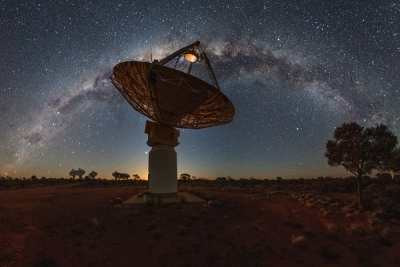
The ASKAP telescope makes images of radio signals from the sky, allowing astronomers to view the Universe at wavelengths that our eyes cannot see. It is a type of radio telescope known as an ‘interferometer’. This means it uses many antennas acting together as one large telescope. In our case, ASKAP has 36 dish antennas spread out over six kilometres in outback Western Australia.
ASKAP’s key feature is its wide field of view, generated by its unique chequerboard Phased Array Feed (PAF) receivers. Together with specialised digital systems, a PAF creates 36 separate (simultaneous) beams on the sky which are mosaicked together into a large single image. This gives ASKAP the ability to rapidly survey large areas of the sky – making it one of the world’s fastest survey radio telescopes. ASKAP will help to answer some of the most fundamental questions of 21st century astronomy and astrophysics involving dark matter, dark energy, the nature of gravity, the origins of the first stars, the evolution of galaxies and the properties of magnetic fields in space.
ASKAP is located at CSIRO’s Murchison Radio-astronomy Observatory (MRO) in Western Australia (WA). The MRO is about 700 kilometres north of Perth in the Murchison Shire, on the traditional lands of the Wajarri Yamaji. Situated in Mid West WA, the Shire covers an area of 49,500 square kilometers and has a population of 120 people.
This remote location is ideal for radio astronomy as there is minimal interference from Earth-based radio transmissions. In the same way that it is necessary for us to avoid city-lights when we’re looking up at the stars, radio telescopes must avoid other radio communication networks that disrupt the signals being received from space.
Picture Credit : Google

